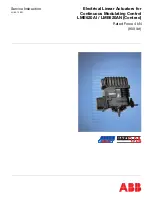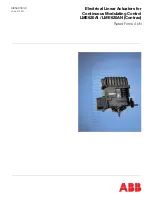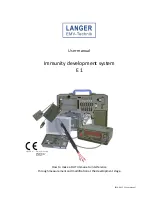
HPM6 Power Management Controller User Manual
Page 143 of
146
13.
COMMISSIONING
13.1
STEP 1: SINGLE UNIT DEBUGGING
a)
Check the parameter configuration of the controller;
b)
Check the genset connections and MSC CAN connection lines between the units. (E.g. if 3
generators are correctly connected, main screen will display Module Number: 3).
c)
Start the genset in semi-auto mode, check if generator data is normal;
d)
Start the genset in semi-auto mode, check if switch opens and closes normally;
e)
Start the genset in semi-auto mode, after closing the breaker, check if generator frequency can be
adjusted to the rated frequency (e.g. set the rated frequency as 52Hz/48Hz);
f)
Start the genset in semi-auto mode, after closing the breaker, check if generator voltage can be
adjusted to the rated voltage (e.g. set the rated voltage as 440V/360V);
g)
Start the genset in semi-auto mode, after closing the breaker, check if power factor, active power
and reactive power are normal; if abnormal, check generator voltage and current phase sequence,
current transformer incoming line direction, current transformer secondary current dotted terminal.
13.2
STEP 2: SEMI-AUTO PARALLEL OPERATION OFF-LOAD
a)
Semi-auto close parallel sets, check whether units synchronization is balanced and breaker close
impulse current is too high; if that, adjust synchronization control parameters appropriately;
b)
During parallel operation off load, check if there is no high circumfluence on HPM6 current screen;
c)
During parallel operation off load, check if the output of active and reactive power is equal to zero;
if it is not, then check if there is power oscillation; if there is, adjust the gain and stability values of
engine, or adjust engine GOV or generator AVR gain and stability potentiometer to avoid active and
reactive power oscillation; output close to 0; if relay adjusts speed/voltage, the droop function of
speed adjusting panel and voltage adjusting panel should be opened and make droop
characteristics be consistent.
13.3
STEP 3: SEMI-AUTO PARALLEL OPERATION ON-LOAD
a)
Semi-auto close parallel sets, perform on-load test and check if active and reactive power is evenly
distributed between all the gensets;
b)
Semi-auto close parallel sets, perform soft on-load test to see if there is high overshoot or power
oscillation during this period; if there is, adjust load slope properly;
c)
Semi-auto close parallel sets, perform soft off-load test to see if genset breaker opens after
reaching minimum set value (%);
d)
Semi-auto close parallel sets, perform impact load test and damp load test to check if there is
power oscillation.
13.4
STEP 4: AUTOMATIC PARALLEL OPERATION
When the controller is in auto status, if there is no power on bus, it will carry out automatic parallel,
start and stop operation.
a)
Start the genset which has the highest priority or shortest running time according to the start mode;
b)
The genset which has the second highest priority or second shortest running time will start if the




































